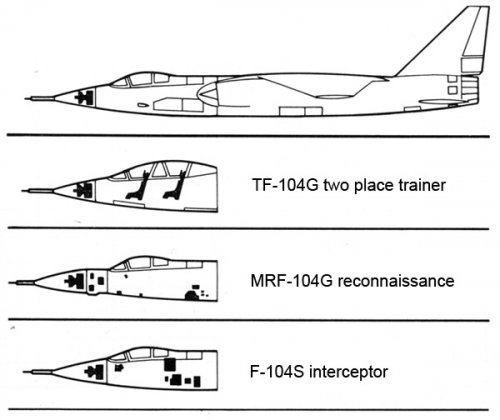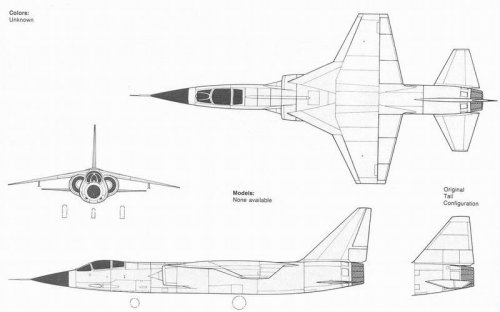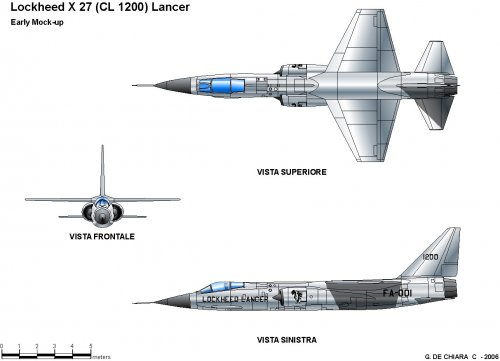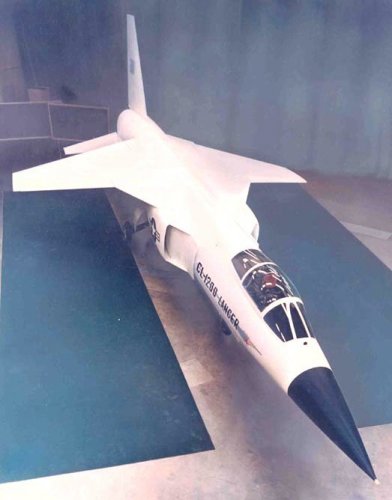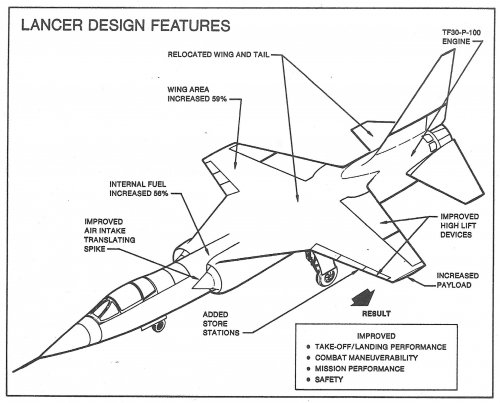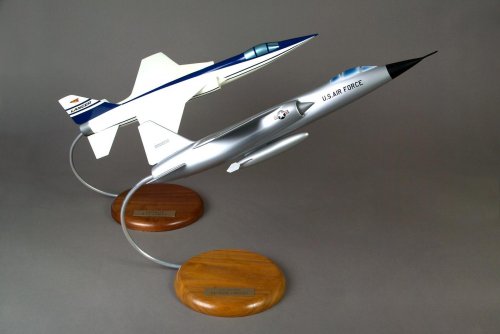- Joined
- 27 December 2005
- Messages
- 17,707
- Reaction score
- 26,149
LANCER
Developed from the Lockheed F-104 Starfighter, the CL-1200 Lancer is now on offer to European nations requiring an advanced combat aircraft for local production. Complete details of the proposal are published here.
A COMPREHENSIVE market survey conducted by the Lockheed-California Company indicates a possible world-wide market for over 7,500 advanced-design, reasonably-priced fighters during the next decade. This forecast is based upon a study of existing fighter forces and the assumption that they will be updated on a one-for-one basis. It excludes the USA, Britain, France and Sweden, since these nations are expected to meet their own requirements with domestic designs.
The size of the potential fighter demand explains the current intense competition, particularly among US manufacturers, to launch a new aircraft capable of capturing at least some of this lucrative market. Even a 10 per cent share, representing, say, 750 aeroplanes by 1980, would be a worthwhile programme, but it is by no means impossible that the right aeroplane could capture as much as 30-40 per cent of the market. There is, of course, no single specification which would meet the needs — apparent or real — of all the various nations making up the total fighter market, but the requirement can be broadly defined as being for an air-superiority fighter to counter the threat of air space domina¬tion by large numbers of high-performance enemy (Soviet-manufactured) fighters based only a short distance away.
To counter this threat, the new fighter must be able to react quickly to any airborne intrusion by enemy aircraft, and must have superior combat performance and duration. Unit cost is also of great significance, however, for this will determine the number of aircraft that any given nation can afford, regardless of the numbers actually needed to counter a given threat. For a significant portion of the potential market, the opportunity to share in production of the new fighter is also important.
The current range of air-superiority fighters was dis¬cussed in some detail in AIR ENTHUSIAST Vol 1 No 1 ("The Fight for the Skies", page 5 et seq), but so far as the Lockheed-defined market is concerned, the major contenders now appear to include the Dassault M irage F1; the Northrop P.530 Cobra; the McDonnell Douglas F-4E(F) and Lock¬heed's own proposal, the CL-1200-2 Lancer. Of these four types, the Mirage Fl is flying and is in production for one customer; the F-4E(F) is a major modification of the Phantom II (over 4,000 built) and has been ordered by one customer; the Lancer is a major modification of the Star-fighter (nearly 2,500 built) and not as yet ordered, and the Cobra is a wholly new design also yet to be ordered.
In proposing the Lancer, Lockheed has sought to derive maximum benefit from its Starfighter experience, not only in the design of the new aircraft through commonality of structure and systems wherever possible, but also by making use of past investment in tooling, factory facilities and equipment, and of experience in organising consortium-production. About half of total F-104 production (1,212 aircraft) was undertaken by a consortium of four European nations, and two of these, Germany and Italy, still have the type in production. Moreover, nine European countries are at present operating a combined total of about 1,170 F-104s, and six other nations are also flying the Starfighter elsewhere in the world.
Development of the Lancer, if a go-ahead is received, would be handled by the "Skunk Works", or, to give this unique organisation its proper name, Lockheed's Advanced Development Projects (ADP) unit in California. Headed since June 1943 by C L "Kelly" Johnson, the "Skunk Works" has complete facilities for design, development and production, and operates within an environment of strict security and minimum administrative restraints, permitting rapid progress at low cost. The "Skunk Works" has been responsible for the design and prototype construction of the P-80 Shooting Star, the XF-90, the JetStar, the F-104, the U-2 and the YF-12/SR-71. It has also handled all work on the Lancer to date, including configuration studies and wind tunnel tests.
Minimum cost
By using as much as possible of the F-104 and a production-type engine, coupled with the inherently low costs of the "Skunk Works" operation, Lockheed estimate that the cost of developing the Lancer is only $70.5m (£34m). Assuming that the entire production was handled by a European consortium similar to that set up for the F-104, and making use of existing tooling wherever possible, the unit cost of the Lancer is calculated to be $2.7m (£1.2m) for a run of 500 and $2.4m (£1m) for production of twice this quantity. These prices allow for Lockheed to recover development costs based on a fixed price incentive contract, but do not include the cost of five F-104Gs which would provide the basis for constructing Lancer prototypes and would be supplied, it is assumed, by the consortium.
Lockheed has conducted an intensive investigation into the initial support costs and the operating costs of the Lancer spread over 10 years of operation. Initial support costs, comprising such items as spares, ground equipment, manuals, maintenance training, flight training and mobile training sets, are assumed to benefit from prior operation of the F-104, and come out at S330m (£137m) for 500 aeroplanes and $180m (£75m) for 1,000.
The 10-year operating costs assume aircraft utilisation of 20 hours per month, with aircraft disposed in 12-aircraft squadrons and 15 pilots per squadron. For a 500-aircraft force (with 420 operational) the total 10-year cost is $2,085m (£870m); for 1,000 aircraft (with 840 operational) it is $4,063m (£1,690m). Adding the first cost, initial support and operating costs together, the total Lancer programme costs over 10 years work out at S4,025m (£1,675m) for 500 aircraft and $7,193m (£2,398m) for 1,000 aircraft. Lockheed claims that these figures represent total savings, compared with similarly-calculated F-4E(F) costs, of $1,386m (£578m)
and 81,955m (£815m) respectively. Compared with Mirage F1 costs, the savings work out at 876m (£31.2m) and $207m (£86-2m) respectively.
Technical details
Evolution of the Lancer design is part of a continuous process aimed at getting maximum benefit from the basic Lockheed F-104 configuration. This process has led to a number of design proposals for improved F-104s, of which the CL-1200-2 is the latest. The research, development, test and evaluation phase of the latest project began in November 1969, since which time the company has conducted (at its own expense) extensive configuration studies, wind tunnel tests and preliminary design phases.
The major changes to the F-104 basic design to produce the Lancer were made with the primary goal of improving manoeuvrability and eliminating pitch-up. They include:
a. Enlarging the wing area by 53 per cent and relocating it in a high position.
b. Enlarging the tailplane and relocating it low on the fuselage.
c. Enlarging the fin area.
d. Providing a 46 per cent increase in internal fuel capacity, by lengthening the fuselage and including wings tanks.
e. Improving the air intake design.
f. Improving the high lift devices on the wings.
g. Providing additional stores positions on the wings.
h. Substituting a Pratt & Whitney TF30-P-100 engine for the General Electric J79 used previously.
The Lancer wing comprises outer panels which are vir¬tually identical with the wings of the F-104. New inner portions are fitted, increasing the span and area, and delta-shaped surfaces extend from the air inlet to the leading edge of the new wing portion, the effect of these extensions being to improve the fighter's airfield performance and lower the trim drag in high speed manoeuvres. Trailing edge flaps in the new wing portions double the available flap area to improve the field performance, and very low landing speeds are claimed for the Lancer without resort to boundary-layer control.
Automatic operation of the wing leading and trailing edge flaps is provided during aerial combat — if the appropriate mode is selected by the pilot — as a function of the load factor, speed and altitude. Also to improve manoeuvrability, the maximum deflection angle of the variable incidence tailplane is increased from 17 deg to 25 deg.
Choice of the TF30-P-100 engine (as used in the F-111F) gives 60 per cent increase in thrust at maximum power for a weight penalty of only 190 lb (86 kg) compared with the J79-GE-11A in the F-104G. The diameter of the TF30 is slightly greater, requiring an increase in the cross section of the Lancer's rear fuselage, and the intakes are both larger and stronger to cope with the increased air mass flow. The intakes incorporate translating shock cones — with about 4 in (10 cm) movement — in place of the F-104's fixed cones, and embody boundary layer diverter plates. Operation of the shock cones to the optimum position for any given Mach number is by electro-mechanical actuators through a control unit receiving inputs from the air data computer.
Structurally, the Lancer airframe is similar to the F-104. The fuselage is a semi-monocoque structure and the forward section (identified as segment 231 in the F-104 breakdown) is identical with that of the F-104G with the exception that the windshield is of F-104S-type to withstand the increased aerodynamic heating due to the higher Mach number at which the Lancer flies. The commonality of this fuselage section means that any proven Starfighter front fuselage can be used on the Lancer, including the two-seat TF-104G section, the F-104S nose with Sparrow missile electronics system for all-weather interception operations, and reconnaissance sections with radar, infra-red or photographic equipment.
Aft of the forebody retained from the F-104, a 30-in (76,2-cm) long barrel section is added to provide additional volume in the fuselage for fuel, if required. The landing gear and support structure are retained from the F-104, but the structural load path of the fuselage centre section is simplified, as the fuselage no longer has to carry the wing bending loads. As a result, the fuselage structure is simplified, with improved fatigue life. Structural materials in the forward and centre fuselage sections are similar to those in the F-104G and S, but the rear fuselage materials are radically different, in that extensive use is made of commercially-available titanium alloy, 6A1-4V, for the frames, major longerons and tail cone around the engine jet pipe.
The wing design uses a multi-beam box structure with machine-tapered skins. Although the outer panels are the same as the F-104G wings, the complete structure is one continuous element, and structural provision is made for a supplementary fuel tank between the two main spars. If all the additional fuel and weapon load options are taken up, the gross weight of the Lancer may go as high as 35,000 lb (15,875 kg) compared with the normal maximum take-off weight of 28,800 lb (13,065 kg), which is the same as the Starfighter's. For the higher gross weight, an optional strengthened landing gear is available, at a weight penalty of 180 lb (82 kg).
Flight control surfaces are conventional and similar to those of the F-104G, apart from the introduction of clam¬shell type speed brakes in the base of the fin, beneath the rudder. These take the place of the speed brakes in the rear fuselage of the F-104. No provision is made for automatic pitch control, as used in the F-104, since wind tunnel tests have shown that the CL-1200-2 remains completely con¬trollable at extreme angles of attack. No artificial stall warning devices are needed.
The electrical system is essentially unaltered from the F-104G, other than using brushless-type generators and solid-state voltage control devices. The hydraulic system differs only in the size of the actuator components. Avionics fit depends on the requirements of the user, the basic F-104G package being offered as a reference point. Altern¬ative off-the-shelf equipment is available to provide a more advanced capability at lower weight.
Fuel tanks in the centre fuselage contain a total of 833 Imp gal (3 787 1) and are the same as those in the F-104G. This internal capacity can be increased to 1,090 Imp gal (4 955 1) by using the optional extra fuselage tank and wing tanks. In addition the wing is stressed to carry four external fuel tanks, two of 142 Imp gal (646 1) each at the tips and two of 162 Imp gal (736 1) on outboard pylons. A further 100 Imp gal (454 1) can be carried in tanks replacing the built-in gun armament when the Lancer is used for extended-range or ferry missions.
Weapons and performance
The Lancer retains, as built-in armament, the 20-mm General Electric M-61 multi-barrel cannon, located in the lower front fuselage to port. This gun can be used for air-to-air or air-to-ground firing and the Lancer carries 725 rounds for it, sufficient for just over 7 seconds firing at the gun's maximum rate of 6,000 rpm. A 30-mm DEFA gun can be fitted in the fuselage, with 400 rounds, as an alternative.
External pylon stations can be provided under the fuselage (one), under each wing (three) and at the wing-tips, providing for a wide variety of external stores, either air-to-air or air-to-ground. For the air-to-air interceptor role, AIM-9D Sidewinders can be carried on all eight stations plus two on the fuselage pylon, and for short-range air-to-ground missions, up to 12,000 lb (5 445 kg) of external ordnance can be lifted on the six wing pylons. The actual combination of stores that can be carried depends both on the weights of individual items and clearances for loading, carriage and release, but some idea of the possibilities is given in the accompanying diagram.
Lancer in the form described here is a Mach 2.4 aeroplane, and the maximum placard speed is 800 knots (1 483 km/h), equivalent to Mach 1.21 at sea level, compared with 750 knots (1 390 km/h) or Mach 1-13 for the F-104G. Increased thrust-to-weight ratio and wing area bestow significant improvements upon take-off and landing performance. For example, in a typical intercept configuration, the take-off distance of the Lancer is only 52 per cent of the distance required by the F-104G, being 1,450 ft (442 m) to lift-off at 156 knots (289 km/h). Similarly, the landing run, clean with 1,000 lb (454 kg) of fuel remaining, is 2,060 ft (628 m) with touchdown at 118 knots (219 km/h) compared with the 2,450 ft (747 m) required by the F-104G after touching down at 156 knots. A drag parachute is used for landing, and an arresting hook is fitted as standard; if the optional 35,000 lb (15 875 kg) gross weight version is adopted, a 16.5ft (5.0m) diameter ribbon type drag 'chute is fitted.
Rate of climb of the Lancer at sea level is greater than 60,000 ft/min (305 m/sec), reflecting the aircraft's high SEP (specific excess power). In the intercept role, the Lancer could, it is calculated, be expected to make an interception at 59,900 ft (18 257 m) nine minutes after brake release, and the mission radius in this case would be 138 naut miles (256 km), allowing for the use of the afterburner from takeoff and all the time until combat, with two minutes at Mach 2.0 before the return to base. For an air superiority mission, providing cover for ground attack aircraft, the Lancer has a mission radius of 398 naut miles (738 km/h).
Ground attack is a secondary role for the Lancer, for which, as already noted, it can carry up to 12,000 lb (5 445 kg) of bombs or other weapons. On a typical mission of this kind, with four 1,000 lb (454 kg) Mk-83 bombs and a full load of gun ammunition, it would have a mission radius of 366 naut miles (678 km) flying at Mach 0-7 at sea level and allowance for five minutes at military rating over the target. At a distance of 200 naut miles (370 km) from base, it could loiter for one hour.
The configuration options for the Lancer have already been noted, including improved avionics systems, additional wing pylons, extra fuel, etc. Other possibilities are a Nord AS-30 missile installation; linkless feed ammunition for the 20-mm gun; Sparrow missile installation; and self-contained starter. A longer-term possibility is the development of a Mach 3.0 version of Lancer, using titanium skin structure, new inlets and an advanced engine such as the Pratt & Whitney F401-PW-400 under development for the Grumman F-14B.
Programme
In order to launch the Lancer, Lockheed requires a firm commitment from one or more nations which would ensure recovery of its development costs of $70-5m (£34m). The proposed programme provides for the construction of four CL-1200-2 prototypes plus a specimen for static structural testing. To produce these in minimum time and at lowest possible cost, five F-104G airframes would be used, or at least five sets of F-104G assemblies and components that are common to the CL-1200-2.
First flight of the first prototype would take place 12 months after go-ahead, and the last of the four within 18 months. Category I
tests,coveringhandlingandperformance, would be conducted by Lockheed ADP, with the customer or consortium of customers conducting the Category II evaluation to obtain a fully qualified air-superiority fighter 24 months after go-ahead.
In a separate proposal, Lockheed has suggested that the USAF should support the construction of two prototypes of the CL-1200-2 to obtain, at low cost, high-performance research aircraft which would be capable of testing various advanced-technology high-performance engines and items of equipment. The proposal is being studied, and the designation X-27 has been assigned to the Lancer by the USAF for this purpose. Should construction of these prototypes go ahead, at least a portion of the development costs would then be covered, making the Lancer proposal look even more attractive to the potential customers in Europe and elsewhere. With the Lancer, Lockheed is pursuing the philosophy of taking a good product and making it better. The widespread use of the F-104G, especially within NATO, makes the project of immediate interest and the opportunity for European and other nations to participate in the development and production of a modern high-performance warplane whilst at the same time making maximum use of past investments in tooling and plant facilities enhances that interest.
In addition, a number of potential markets outside the European aerospace manufacturing community can be identified and therefore a manufacturing consortium would stand a good chance of earning useful revenues from exports. For example, Lockheed has noted 20 countries that now operate jet fighters — in many cases of obsolescent types — and that in the past have spent or shown a willingness to spend their own resources to acquire jetfighters.These countries include Norway, Denmark, Italy, Greece, Turkey, Spain, Switzerland, Portugal, Saudi Arabia, Iran, Lebanon, Israel, Pakistan, Jordan, New Zealand, Australia, India, South Africa, Malaysia and Indonesia.
Modern aerodynamic design and provisions for future growth by incorporating more modern avionics equipment and more advanced engines as they become available, give the Lancer good potential for long operational life as a front-line fighter. This, coupled with economy both in first cost and continuation costs, provides the Lancer with excellent military capability within budget constraints. Certainly none of the Lancer's competitors can be launched at such low cost and this factor alone must give the project a good chance of going ahead. With several significant national fighter selections nearing completion, the first Lancer could well be in the air before the end of 1972.
Air Enthusiast, September 1971




